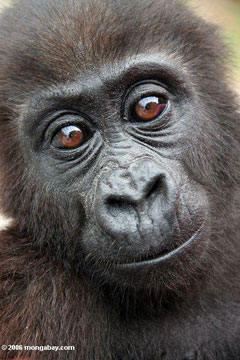48% of primates threatened with extinction
48% of primates threatened with extinction
mongabay.com
August 5, 2008
|
|
48 percent of the world’s primate species are at risk of extinction, according to the first comprehensive review of the world’s primates since 2003. The results were released as an update to the IUCN Red List at the 22nd International Primatological Society Congress in Edinburgh, Scotland.
Of the 634 types of primates known to science, 11 percent were listed as Critically Endangered, 22 percent Endangered, and 15 percent Vulnerable. The results are the worst of any animal group on record, surpassing even the highly-threatened amphibians and corals.
“We’ve raised concerns for years about primates being in peril, but now we have solid data to show the situation is far more severe than we imagined,” said Russ Mittermeier, president of Conservation International (CI) and the chairman of the IUCN Species Survival Commission’s Primate Specialist Group. “Tropical forest destruction has always been the main cause, but now it appears that hunting is just as serious a threat in some areas, even where the habitat is still quite intact. In many places, primates are quite literally being eaten to extinction.”
 Gorillas are at risk due to habitat loss, poaching, and outbreaks of the ebola virus and other diseases.  Orangutans in Borneo (above) and Sumatra are threatened by the pet trade, logging, and expansion of oil palm plantations in Malaysia and Indonesia. Photo by Rhett Butler |
Asia had the highest proportion of threatened primates at 71 percent. Researchers attribute the dire status of Asian primates to large-scale habitat loss and hunting as food and to supply the wildlife market for Chinese medicine and pets.
“What is happening in Southeast Asia is terrifying,” said Jean-Christophe Vié, Deputy Head of the IUCN Species Program. “To have a group of animals under such a high level of threat is, quite frankly, unlike anything we have recorded among any other group of species to date.”
The situation is Africa is not much better. 11 of the 13 kinds of red colobus monkeys assessed were listed as Critically Endangered or Endangered, including two of which — Bouvier’s red colobus (Procolobus pennantii bouvieri) and Miss Waldron’s red colobus (Procolobus badius waldroni) — have not been seen in more than 25 years.
“Among the African species, the great apes such as gorillas and bonobos have always tended to grab the limelight, and even though they are deeply threatened, it is smaller primates such as the red colobus that could die out first,” said International Primatological Society President Richard Wrangham.
However not all news on primates is bad. Scientists continue to discovery unknown species: 53 “new” primates have been described since 2000. And research shows that provided with sufficient habitat, some species can recover from the brink of extinction. Two examples can be found in the Atlantic forest of Brazil: both the black lion tamarin (Leontopithecus chrysopygus) and the golden lion tamarin (Leontopithecus rosalia) have been downlisted to Endangered from Critically Endangered.
“If you have forests, you can save primates,” said CI scientist Anthony Rylands, the deputy chair of the IUCN Primate Specialist Group. “The work with lion tamarins shows that conserving forest fragments and reforesting to create corridors that connect them is not only vital for primates, but offers the multiple benefits of maintaining healthy ecosystems and water supplies while reducing greenhouse gas emissions that cause climate change.”